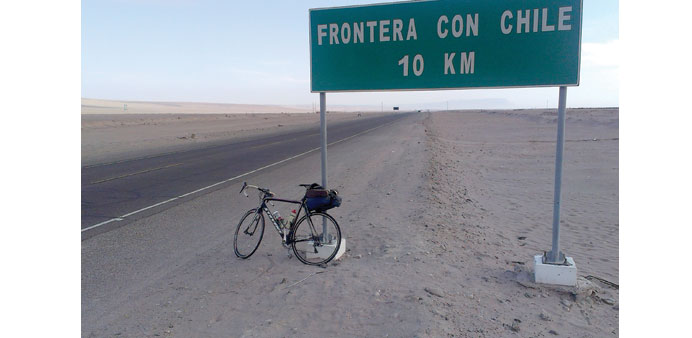Georg Ismar's bike with just 4 kilograms of bare essentials in the Peruvian desert, leaned against a sign that announces 10 kilometres to go before the Chilean border.
By Georg Ismar
The policewoman looks somewhat surprised to see a racing bike being assembled in front of the airport building in Tacna, Peru. Cycling on the legendary Pan-American Highway is not exactly a popular sport in the South American country.
The first problem: what to do with the zip-up bag used to carry the bike on the flight from Lima?
Officer Miriam Solhe offers to help. She puts the bag in the back of her police pick-up.
“I’ll keep it in storage at the police station until you’re back,” she says. But this will require paperwork.
She takes both of my thumbprints on a form. Rules are rules.
Now, with my bag safely in police custody and 4 kilograms of just the barest essentials loaded on the bike, the road from the airport leads onto the Panamericana on a route that heads down to the Pacific coast and then high up into the Andes.
The road moves through desert landscapes that are almost like moonscapes. At the border with Chile the bike has to be disinfected because of a cattle disease in Peru. After another 25 kilometres the Pacific can be smelt and the Chilean port city of Arica is reached.
The next morning over breakfast, the ride ahead looks daunting. From sea level at zero metres there’ll be a climb to 4,700 metres — there are hardly any other mountain-pass roads in the world that are as long or as high.
First the road winds moderately through the green Lluta valley. After 50 kilometres, there’s a break for empanada pastries and freshly squeezed orange juice. Then there are almost 70 kilometres of nothing much.
Truckers honk their horns encouragingly as they haul freight from Chile to La Paz in Bolivia. The well-paved road climbs ever higher, past deserts of stones and surreal landscapes. Soon the water supplies are exhausted and thirst becomes a problem.
The road goes uphill for another 10 kilometres, then the first building for a very long time appears — a potash factory. The watchmen are surprised to see a cyclist. Fortunately there’s a water dispenser.
The route continues upwards and the shadows cast by the wheel grow longer.
At a mountain lake there’s a sign advertising natural juices. Just as well, as the water bottles are empty again. The bicycle’s digital logger is showing an altitude of 2,700 metres. In a hut lives a man with coca tea — good against the altitude.
After another 15 kilometres, there appears a settlement of three ramshackle huts and a trucker pub. This is Zapahuira. For 4 euros (4.40 dollars), there’s a bed available but no shower — difficult after a sweaty day.
Outside the dogs bark, the night is clear and there are plenty of stars to look at. A look at the logger shows that 115 km has been travelled and a height of 3,400 metres attained — at a depressing average speed of just 15 km/h.
There’s bright sunshine next morning and after a few hours, the water has run out again. Fortunately there’s a military post with water. The road leads into the Lauca national park. The white Andes mountains are visible and the road goes past lakes where flamingos cavort.
Around 4 pm, Lake Chungara is reached, framed by snow-capped volcanoes. Condors soar overhead while alpacas graze. In the so-called Saltpetre War fought here in 1879-1883, Bolivia lost its access to the sea to the victor, Chile. Today there’s still a demilitarised zone here.
The highest point in the mountain pass at 4,700 metres is the border. “Welcome to the Plurinational State of Bolivia,” the sign says.
Some photos and then a few kilometres descent to Chungara-Tambo Quemado, a mountain pass which connects Arica and La Paz. Almost 220 kilometres have been travelled since leaving Arica.
On a speedy descent through the thin mountain air, I overtake trucks gingerly descending the grades. At one point, my logger displays my speed as 102.7 km/h. The air is so thin here it offers little resistance to the rider. Then into the border area, where there’s hunger and thirst to be slaked, but unfortunately no hotel. No matter though, the epic bike crossing has been achieved. From here, it’s best to take a coach to La Paz, the Bolivian capital.
Mixing coach and riding stages, the great circuit continues to Lake Titicaca and Moquegua, Peru, before the bike takes me down the solitary and magnificent curves of the Panamericana back to Tacna.
Officer Solhe is waiting for me at the police station to return my bag.
“You’re a bit ‘loco’,” she says with a smile. —DPA



